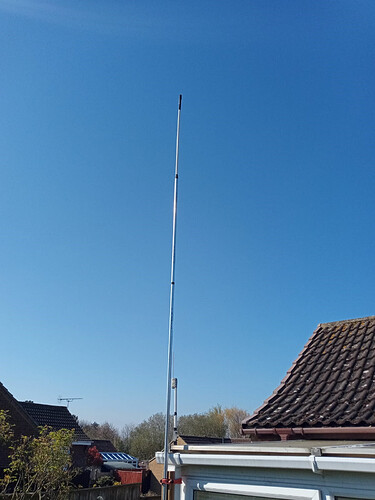thanks very much fir your quick reply, and have a nice weekend ![]()
Almost.
It it copper deposited on PET (same material as soft drink bottles).
It’s cheaper and more flexible than coper foil, but don’t try to solder it!
Test (not a scientific side-by-side).
ADSBx antenna until 12:45
DIY 6 element CoCo after that.
Everything else in setup was the same except antenna and “N male - F female” connector (in case of ADSBx antenna).
Conclusion:
Two possible variants:
- CoCo is better with my setup, location, etc.
- Connector that I used is bad. Ordered other one that clearly state that it is 50 ohm one (not sure if it matters a lot in this case).
I’m open to suggestions what else could be wrong with my ADSBx setup.
Possiility: ADSBx antenna picks more RF Noise (Cell / Mobile UHF TV Signals) than CoCo. Do you use a filter? Run RF Scan for both the antennas and compare.
Not sure what to make out of it due to lack of deep knowledge.
DYI (no filter)
ADSBx (no filter)
DYI (with Uputronics LNA)
ADSBx (with Uputronics LNA)
DYI (with Uputronics LNA + FA blue filter)
ADSBx (with Uputronics LNA + FA blue filter)
Seeing the performance graphs and RF scans, it seems your CoCo is better than ADSBx antenna.
What is the top element of your CoCo? 1/2 wave, 1/4 wave with center wire projecting in air, center wire shorted to braid etc etc.
From the performance graphs yes, from the RF scans i’d disagree, the last two pictures the adsbx antenna actually shows more 1090 and less out of band than the Coco.
I’d say the adsbx antenna is picking up more in band interference, something like HDMI or other broadband EMI.
Now that could be caused by a different gain / azimuth profile.
Somehow the noise floor seems to be raised.
Looking at the performance graphs once more, it seems the message rate doesn’t change much but the position rate changes a lot.
From experience i’d say that could be the difference between getting TIS-B messages and not getting them.
They are few messages so wouldn’t affect that but they all contain a position so it would affect that graphs.
Now one would still need to determine how TIS-B reception changes with the antennas while also keeping in mind TIS-B isn’t necessarily always broadcast.
The ADS-B range isn’t great with either antenna, that points to either terrain or just a bad indoor location.
/tar1090/?pTracks for the same timeframe for two weekdays would be interesting.
In case of an indoor location … very slight location and environment changes can make a big difference.
This is even more true in regards to TIS-B, one antenna could have better line of sight to the tower than the other one resulting in skewed figures.
@abcd567 It is half wave, same as other CoCo pieces. I tried 1/4 piece and 1/4 piece shorted a while back and it did not make much difference in my case.
@wiedehopf If it HDMI interference, do you think it coming over the air or somehow through power supply? I will try to move setup to the next room to see anything changes.
That would just be proximity to the HDMI cable / devices.
And with proximity i mean probably 10 to 20 feet? Not sure exactly.
Home-build coaxial collinear ADS-B antenna
I used RG6 coaxial cable and followed the instructions from this youtube video (2) Making an inexpensive 1090MHz ADS-B collinear antenna - YouTube to create an 8-element, half-wave length antenna. Work out the overall length of cable required including for the length of the feeder, which should be as short as practical, and will depend on where your antenna is to be mounted. After some experimenting I ended up using a 3M length of 20mm PVC conduit with the co-axial cable threaded through, with the PVC conduit in turn threaded through a 3M length of 25mm galvanised conduit (for additional stability) and with the antenna (1m) protruding from the top of the PVC. Seal the top end of the PVC tube (I used PVC insulating tape) but self-amalgamating tape would be better. If you want the mast to be de-mountable (which mine is) make a joint at the appropriate place in the co-axial cable so the mast can be taken down as required. I had seen lots of comments about home-build coaxial collinears being hit-and-miss, but from my experience, careful measuring and cutting will produce very acceptable results. My antenna is mounted at approx. 5m (overall height above sea level 19m) and I am reaching over 200nM, with RSSI ranging from -1.2 to -17 and with an ADS-B only conversion rate of roughly 7.5% which I gather is somewhere near norm. Cost was minimal, with the conduit about £10, the cable I already had. Give it a try – always willing to help out with advice from my albeit limited experience.
This topic was automatically closed 365 days after the last reply. New replies are no longer allowed.








